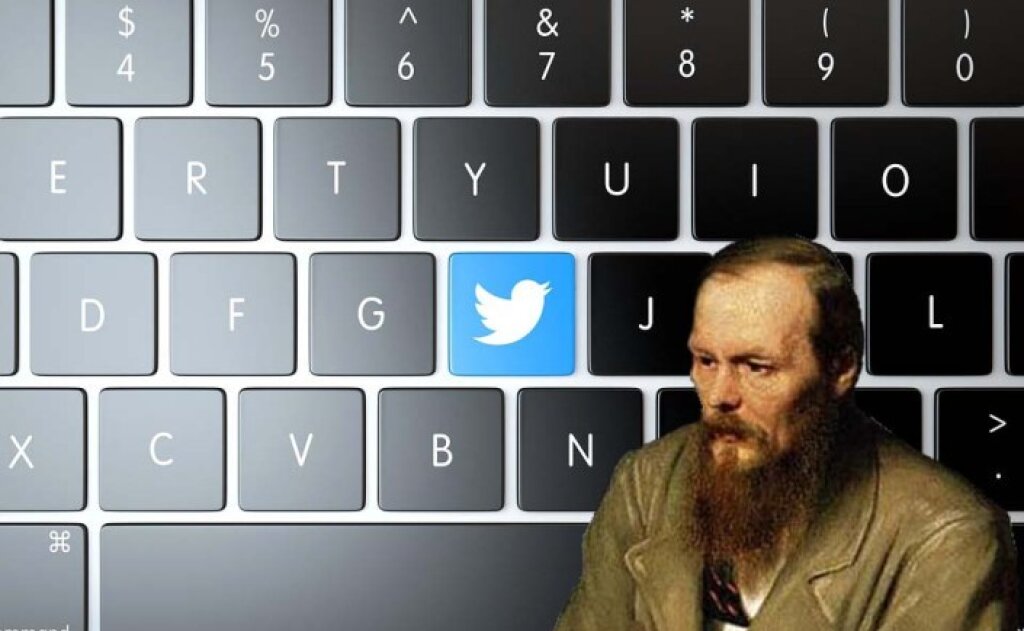This post originally appeared on The Bloggers Karamazov, the Official Blog of the North American Dostoevsky Society. It emerged from a roundtable on “Teaching Dostoevsky in the 21st Century” organized by Daniel Brooks at the 2019 AATSEEL conference in New Orleans. This is the third in a series of posts by roundtable participants; the first may be found here, and the second here.
Katherine Bowers is an Assistant Professor of Slavic Studies at the University of British Columbia. Her publications include the recent co-edited collection A Dostoevskii Companion: Texts and Contexts (2018). She edits Bloggers Karamazov and curates the Society’s social media. She can also be found on twitter @kab3d.
My adventure with Twitterature began three years ago, when I began to work with the North American Dostoevsky Society as their social media curator. I began a twitter account for the society, and it quickly took off. Throughout 2015 we had some success with contests that aimed to engage our followers and encourage them to join an online conversation about Dostoevsky. There was a humor contest, a hoodie design competition, a quote competition— and all of these events were great, boosted membership, and really helped us create a kind of community, but there was one issue. We wanted to engage not just with the kind of commercial idea of Dostoevsky, but with Dostoevsky’s works on a deeper level, and these kinds of contests were fun but they didn’t really do that. This is where the question that framed my AATSEEL talk and this blog post really begins: social media is useful for sharing information, community building, and public engagement – but can it enhance the study of literature? And, if yes, how?
In fall 2015, the North American Dostoevsky Society staged an online event. #TheDoubleEvent was centered around Dostoevsky’s 1846 novella, and aimed to get people talking about the text itself. The idea was that we would encourage people to read the novel and post reflections on it to our social media. This group read would lead up to a screening of The Double, the 2013 Richard Ayoade film adaptation of the novel, which would take place on multiple campuses. We wanted to connect people reading the novel and watching the film via Facebook and Twitter. The reflections were kind of a bust – as you can probably imagine, the only people who wrote them were my students, who I bribed with extra credit. Alongside them we had people write posts on Bloggers Karamazov (Gender Trouble in The Double, Gothic Doubling or The Double Gothically, and Golyadkin’s Human Shriek), our then newly launched blog – these were well received, and helped give the event a bit more depth. The film screening and live tweet event was great, and showed us the power of twitter for connecting people in a meaningful way. But perhaps more important to the development of my narrative is the fact that, as a way of engaging with the text and promoting the event, we, Brian Armstrong and I, decided to tweet the novel from its hero, Golyadkin’s, perspective… And this brings us to the topic of Twitterature, that is the creation or representation of a literary text through the Twitter format.
@YakovGolyadkin focused on just Golyadkin’s perspective. The real key to the project was Brian’s finding of Golyadkin’s voice. Brian interpreted the twitter feed to be a kind of monologue, as if Golyadkin had a secret device in his pocket that enabled him to record everything, all his thoughts and events. This enabled him to tweet with some sense of narrative arc, and improvise away from the text a bit, but keep in character. Finding Golyadkin’s voice enabled the feed to emphasize the key ideas of the novel, but, at the same time, to allow them to blend into the mundane everyday details of the feed. It also enabled the separation of Golyadkin’s voice/perspective from that of the narrator, an interesting extraction that enabled new readings of the novel. When I teach Dostoevsky, I assign my students to read the novel, and also invite them to read the @YakovGolyadkin Twitter feed (which is preserved on Wakelet and archived on Humanities Commons). They invariably respond well to @YakovGolyadkin. The singling out of Golyadkin’s voice and the timeline embedded in the preserved Twitter account helps with adding more framework to the confusing novel. However, beyond that, I was interested to learn that @YakovGolyadkin enabled them to read the novel differently. Several students reported that they felt much more sympathy for Golyadkin after reading the Twitter feed; they could see how lonely he was. His loneliness exists in the novel, but is difficult to discern through the voice of the narrator and the antics of his double. Similarly, Brian commented that he hadn’t realized how obsessed with prestige Golyadkin was until working on the project. This project showed us the value of digitally reading and recreating a text through Twitter, and we began planning for a grander twitter projectattached to a large celebration of the 150th anniversary of Crime and Punishment that Kate Holland and I were organizing…. And @RodionTweets was born.
We decided to transpose Crime and Punishment into Twitter for the 150th anniversary because we saw it as an exciting new way of reading the novel. To mine the novel for tweets, you have to do incredibly close reading of the text, picking up on nuance and minute shifts in the protagonist’s feelings. Although Dostoevsky originally had begun the novel in the first person, Crime and Punishment is written in the third person, and there are many scenes that Raskolnikov never witnesses. Similarly, some context is required, and so the omniscient narrator’s voice must, at times, be transposed into the first person and into Raskolnikov’s voice. The mediation of these voices in the text makes for an intensive reading experience, and reproducing them into one coherent (or sometimes not so coherent, but always believable) voice was difficult. Assigning a project to students that requires them to mine the text, analyze it on a structural and narrative level, and interpret it to some degree to produce tweets is a wonderful exercise in close reading and one that I will explore closer here with some insight from our own experience doing this.
Our project was complicated by the fact that six different scholars were mining the six different parts of the novel. Even when we are all working from the same translation of the same text, we each approached the task a different way. Kate Holland’s tweets are more sprawling stream-of-consciousness, while Jennifer Wilson’s are very succinct. Kristina McGuirk, my ace RA, had a difficult task in trying to create a single Twitter persona out of them, but found that the Twitter medium helped this task as it required concision and some attention to hashtags. Hashtags seemed somewhat anachronistic, but several of the team members commented afterwards that hashtags proved useful in rendering the text from one person’s point of view. Sarah Hudspith wrote afterwards:
“At the earliest stages of envisaging the novel, Dostoevsky described in a letter to the editor Katkov his plan to write a story about a young man falling under the influence of “strange, ‘unfinished’ ideas afloat in the atmosphere” and committing a murder. I saw that the use of hashtags created a certain emphasis when added to words, and I felt that this would nicely suggest ideas and concepts afloat in the Twittersphere that were preying on Raskolnikov’s mind, even at an unconscious level. In this way, I could highlight the obvious #crime, but also #soul, #sacrifice, #fate and even #deadbody, adding a possibility of a double reading to the exclamation “Over my #deadbody!”
Beyond these questions of voice, there were questions of representation as well, and how the text would best (and most believably) be represented in Twitter format. Sarah Hudspith struggled with whether and to what degree to livetweet the murder, which is minutely detailed in the text, and I was confounded by delirious wandering. Yet, although these moments were confounding, they were also illuminating in that they forced us to think through places in the text in new ways. On livetweeting the murder, Sarah decided to do it in the end, but the decision prompted her to think more about the nature of social media and its meaning for searching for personal meaning:
“We live in an age where many people feel compelled to broadcast their lives online, to create a narrative of themselves which can become more real than the intimate, offline self. Raskolnikov is a character searching for an identity for himself: is he an intellectual, a philanthropist, a pioneer of a new morality, a sensualist, a beloved son and brother, a criminal? What parallels could be drawn between his anguished self-seeking, when put into the context of a Twitter account, and the contemporary mediation of personal identity? Further, social media are increasingly platforms for the propagation of ideologies and their distillation into ever more extreme forms, indeed are sadly the venue for publicising horrific crimes in the name of a so-called ‘new word’.”
These questions of public/private are opened only by reading the novel through Twitter; they are relevant, and important in tying the novel to our 21st-century experience, but they don’t come naturally to a text set in the 19th century.
In addition to reading alongside as I assign my students to do with @YakovGolyadkin and The Double or tweet mining themselves as I have just discussed, Kate Holland has also suggested one classroom activity that would work well with the feed (her students have done this several times): they read a section of the novel and the corresponding section of @RodionTweets, then write a series of tweets from another character that respond to Raskolnikov and the situation. In this way, they are given a small taste of intensive close reading and are encouraged to come to a better understanding of at least one character’s motivations and feelings. For Dostoevsky, who used his characters’ reactions and voices to such good narrative effect, I think twitterature in this sense opens up new avenues to understanding human nature in the classroom and beyond.
And a small public service message: both @YakovGolyadkin and @RodionTweets are preserved as a Wakelet (@YakovGolyadkin, @RodionTweets) and on Humanities Commons (@YakovGolyadkin, @RodionTweets pt 1, @RodionTweets pt 2) for use in the classroom in the future or for interested readers who stumble upon it online.



